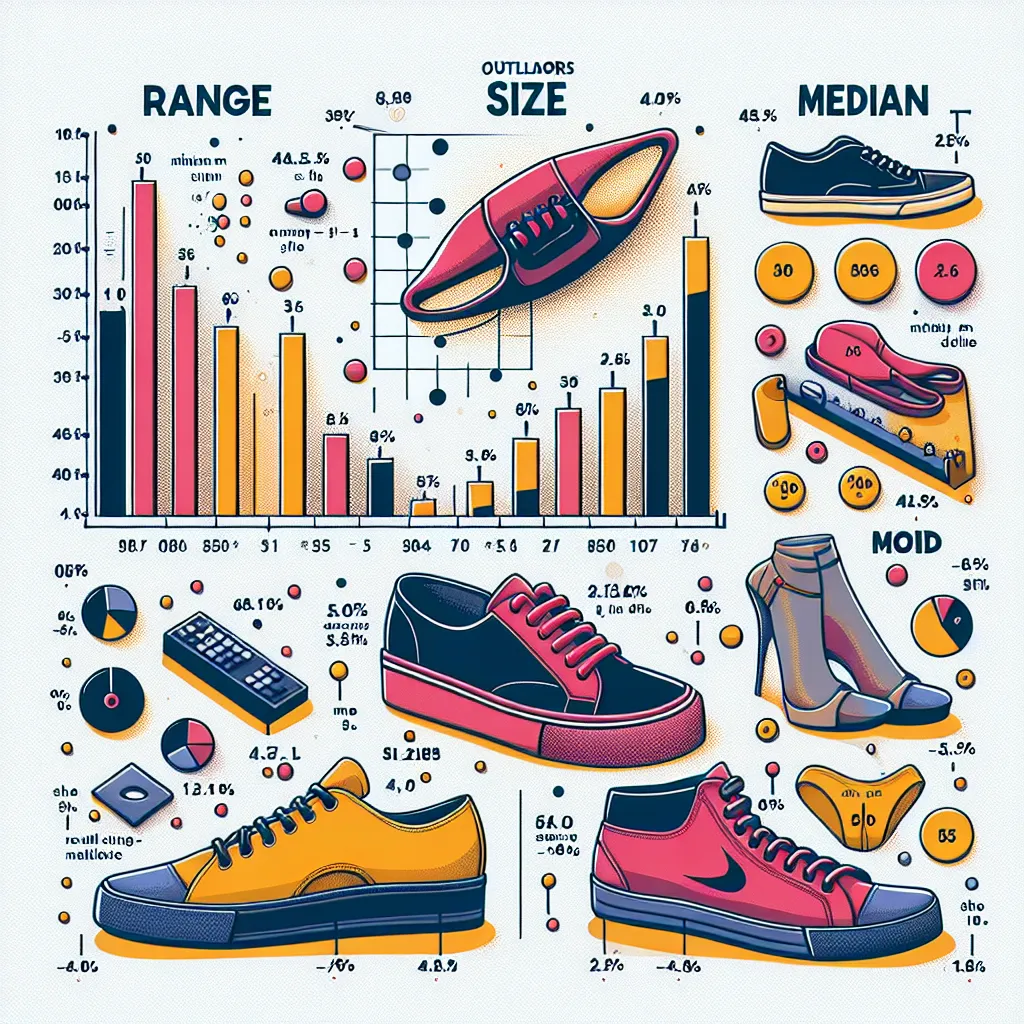Ask AI on The Internet
Question: Question 5 Sizwe is a salesperson at a men's shoe store. His employer asks him to record information about the sizes of the shoes he sells in the space of one week so that she can make business decisions for future purposes. He records 20 sales in a week and records the sizes as follows: 3, 5, 6, 6, 6, 7, 7, 7, 7, 8, 8, 8, 8, 8, 9, 9, 10, 10, 11, 14 Use the data above to determine the following. 5.1. Give the range of the data recorded. (2) 5.2. Give the size of an outlier, if any is available. (2) 5.3. Calculate the mean of the shoe size sold. (2) 5.4. Determine the median of the shoe sizes sold. (2) 5.5. Give the mode of the shoe sizes sold. (2) 5.6. Which of these 3 measures of central tendency (mean, median, mode) would be the most valuable to Sizwe’s employer? Briefly explain your answer. (3)
Let's analyze the data step by step to answer each question. ### Data: Sizes: 3, 5, 6, 6, 6, 7, 7, 7, 7, 8, 8, 8, 8, 8, 9, 9, 10, 10, 11, 14 #### 5.1. Give the range of the data recorded. The range of a dataset is the difference between the maximum and minimum values. - Minimum value = 3 - Maximum value = 14 \[ \text{Range} = \text{Maximum} - \text{Minimum} = 14 - 3 = 11 \] The range of the data is \( 11 \). #### 5.2. Give the size of an outlier, if any is available. An outlier is a data point that significantly differs from other observations. To determine outliers, you can use the interquartile range (IQR) method or visual inspection. Visually inspecting the data, the value 14 seems unusually high compared to other values. To confirm it, let's compute the IQR: 1. Organize data: \[ 3, 5, 6, 6, 6, 7, 7, 7, 7, 8, 8, 8, 8, 8, 9, 9, 10, 10, 11, 14 \] 2. Find the lower quartile ( \( Q1 \) ) and upper quartile ( \( Q3 \) ): - \( Q1 \) is the median of the first 10 numbers: \[ Q1 = 6 \] - \( Q3 \) is the median of the last 10 numbers: \[ Q3 = 9 \] 3. Calculate IQR: \[ \text{IQR} = Q3 - Q1 = 9 - 6 = 3 \] 4. Find lower and upper bounds to identify outliers: \[ \text{Lower bound} = Q1 - 1.5 \times IQR = 6 - 1.5 \times 3 = 1.5 \] \[ \text{Upper bound} = Q3 + 1.5 \times IQR = 9 + 1.5 \times 3 = 13.5 \] Since the value 14 is greater than the upper bound of 13.5, it is an outlier. The size of the outlier is \( 14 \). #### 5.3. Calculate the mean of the shoe size sold. The mean (average) is calculated as the sum of the data points divided by the number of data points. \[ \text{Mean} = \frac{3 + 5 + 6 + 6 + 6 + 7 + 7 + 7 + 7 + 8 + 8 + 8 + 8 + 8 + 9 + 9 + 10 + 10 + 11 + 14}{20} \] \[ \text{Sum} = 3 + 5 + 6 \times 3 + 7 \times 4 + 8 \times 5 + 9 \times 2 + 10 \times 2 + 11 + 14 = 144 \] \[ \text{Mean} = \frac{144}{20} = 7.2 \] The mean of the shoe size sold is \( 7.2 \). #### 5.4. Determine the median of the shoe sizes sold. The median is the middle value of an ordered dataset. Since there are 20 values, the median is the average of the 10th and 11th values: \[ \text{10th value} = 8 \] \[ \text{11th value} = 8 \] \[ \text{Median} = \frac{8 + 8}{2} = 8 \] The median of the shoe sizes sold is \( 8 \). #### 5.5. Give the mode of the shoe sizes sold. The mode is the value(s) that appear most frequently in the dataset. Sizes frequency: - 6 appears 3 times - 7 appears 4 times - 8 appears 5 times (most frequent) - 9 appears 2 times - 10 appears 2 times - 3, 5, 11, 14 appear once each The mode of the shoe sizes sold is \( 8 \). #### 5.6. Which of these 3 measures of central tendency (mean, median, mode) would be the most valuable to Sizwe’s employer? Briefly explain your answer. To determine the most valuable measure, consider that the choice of the measure depends on the nature and objectives of the business decision: - **Mean (7.2)**: It is influenced by the outlier (size 14) and may not accurately represent the central tendency if outliers exist. - **Median (8)**: It isn't affected by extreme values (like the outlier) and represents the middle of the dataset, providing a more accurate central position in skewed data. - **Mode (8)**: It indicates the size that occurs most frequently, which could be useful for inventory management by showing the most common shoe size sold. Considering the presence of the outlier (size 14) and the objective of understanding common shoe sizes sold for inventory and sales planning, the **mode** (size 8) is likely the most valuable measure for Sizwe’s employer. It directly highlights the most popular shoe size, guiding decisions on stocking patterns. #### Conclusion: - Range: \( 11 \) - Outlier: \( 14 \) - Mean: \( 7.2 \) - Median: \( 8 \) - Mode: \( 8 \) - Most valuable measure: Mode (for inventory/sales planning).
Think your answer is better than the AI's? Post it below.
Other Most Relevant Posts:
 Analyzing Data Sets and Lottery Prizes: Unveiling Central Tendency Measures and Comparison of Statistical Values
Analyzing Data Sets and Lottery Prizes: Unveiling Central Tendency Measures and Comparison of Statistical Values
 ### Monthly Costs and Evaluation
#### Monthly payment for Deal 1:
The monthly payment for Deal 1 is **R109** per month.
#### Calculating the Cost for Deal 1:
- Data: 170 MB x R0.40 = R68
- Voice: 90
### Monthly Costs and Evaluation
#### Monthly payment for Deal 1:
The monthly payment for Deal 1 is **R109** per month.
#### Calculating the Cost for Deal 1:
- Data: 170 MB x R0.40 = R68
- Voice: 90
 ### Webpage Title:
Scale and Distance: Mapping and Analyzing South Africa and Neighbors
**Page Summary:** Explore the concept of scale on maps, identify neighboring countries of South Africa, and us
### Webpage Title:
Scale and Distance: Mapping and Analyzing South Africa and Neighbors
**Page Summary:** Explore the concept of scale on maps, identify neighboring countries of South Africa, and us
Question Tags
If you want your question answered by an AI, click here.




Post your own comment: